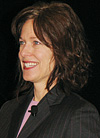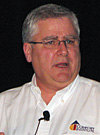
Shelly Miller, associate professor at the University of Colorado, discussed the use of ultraviolet light applications in HVAC systems.
While duct cleaning may be the one service all attendees of the association’s 2008 convention have in common, most participants dabble in far more areas in the heating and cooling industry. And, it’s not like the association is discouraging business expansion, either. Each year, NADCA slides in more HVAC- and IAQ-related programs into its annual meeting - and this year was not any different with such sessions as “Ultraviolet Light: Application in HVAC Systems,” “Optimizing Indoor Air Quality Through Comprehensive Filtration,” and “Current Trends in IAQ.”
It even featured hard-nosed speaker Larry Winget, who was not afraid to tell his audience that it takes hard work to get ahead in any business. His no-nonsense presentation was well received by the more than 400 attendees.
“When NADCA was formed in 1989, the organization represented a small group of individuals focused on promoting source removal as the only legitimate approach to cleaning ductwork,” said Bill Lundquist, NADCA president. “Since then, HVAC cleaning companies of all sizes have begun to take notice of the industry’s many opportunities for expansion. As consumer awareness has grown, ‘duct cleaning’ companies have developed into full-service HVAC inspection, maintenance, and restoration businesses.”
So, they came to sunny San Diego to learn about more growth opportunities as the association focused on the major trends that are shaping the HVAC industry today, as well as transitions that are likely to follow.
“The fundamental question is: Are you a duct cleaner? Or: Do you see your profession, your industry, and your business as more than that?” asked Lundquist. “As I think about these questions and speak with NADCA members, more often than not I hear that our members see themselves as more than duct cleaners. More and more NADCA members are learning how to better meet the needs of their clients, while generating new revenue streams in the process.
“Looking ahead, business owners with the foresight, fortitude, and focus necessary for bold growth will have a wealth of opportunities to pursue.”
MILLION DOLLAR ADVICE
Jeremy Stamkos whetted the appetite of members with his opening general session talk: “Developing a Million Dollar HVAC Cleaning Business.” Stamkos heads Enviroair Pty. Ltd., considered one of the leading ventilation hygiene service companies within Australia. Stamkos took over the company from his father in 2001 and since then Enviroair has more than doubled in size.According to Stamkos, it takes passion, dedication, persistence, skills, and ability to jump from being a dominant player in a local market to becoming the dominant player in a country. The latter is his company’s goal for 2010. He wants to be the dominant global player by 2015.
“You have to have short-term goals and meet each,” he said. “You have to increase market share in sales, brand recognition, skills and knowledge, and capabilities.”
In regard to brand recognition, he said the best ways to achieve this is through advertising, industry associations, and writing articles for trade publications. He added that one cannot build a quality business without employing quality people. In his opinion, one can attract quality people by offering a career in a company that has a promising future, offers decent salaries (“It’s not a glamorous job,” he interjected), and offers opportunities for promotion. You keep these people by “honoring what you originally offered,” provide incentives, and keep them interested.

Ken Summers, a 12-year veteran of Comfort Institute, zeroed in on “Duct Leakage: The IAQ Connections.”
He stressed the need for passion, as “enthusiasm attracts people and business.” In regard to integrity, he said, “Honesty is definitely the best policy.” And when it comes to advertising, “If you are the best, advertise it.”
If he had to start his business today, he would do a few things differently, he added. In the long run, Stamkos recommended keeping focused on one’s core business (translation: limit diversification), getting tough on bad performance, following one’s gut feelings more, and expanding quick. He proceeded to provide members a rundown on what, budget-wise, is involved in assembling a $1 million business.
Some of the pitfalls he noted included bad advice, going too fast too soon, plus bad debtors and cash flow. “Having a bad staff member is like cancer,” he cautioned. “Cut it out before it spreads.”
In summary, he told his audience to establish goals, plan and prepare accordingly, strive for excellence, persevere, and “employ great staff and provide incentives.”

Holly Bailey, from Building Environment Consultants, Inc., informed NADCA attendees regarding optimizing indoor air quality through comprehensive filtration.
TECHNICAL TALK
Speakers Brad Kuhlmann and Ken Summers supplied separate technical sessions. Kuhlmann, owner of Midwest Duct Cleaning Services out of Shawnee Mission, Kan., discussed “Tips and Techniques: Air Handler Refurbishment.” Summers, a 12-year veteran of Comfort Institute, zeroed in on “Duct Leakage: The IAQ Connections.”Kuhlmann is a firm believer that quality control and proper documentation are the best ways to demonstrate professionalism to clients. Through multiple pictures, he showed his audience the fine art of drain pan refurbishment along with insulation removal and replacement. In regard to the first project, it takes initial site preparation before addressing the drain pan.
“Containment of surrounding areas is critical prior to the start of any cleaning to prevent damage to other system components and/or cross contamination of debris,” said Kuhlmann, pointing out that this includes protecting the coils from where cross braces will be coated, in addition to blocking off the return duct so no odors or particulates are drawn through the system and into occupied areas.
“You must employ general work site containment strategies to address zoning off the work site, protecting the surrounding area, and establishing a chain of command,” he said. “Workers and general safety must be considered and all precautions taken to ensure all involved are aware of all the safety parameters.”
In regard to drain pan preparation, Kuhlmann encouraged members to remove all loose debris from the pan, wet vacuum out standing water in the pan, and where rust and debris has significant accumulation, “you must remove all layers in a ‘gross clean’ prior to a final or detail clean,” he said.
With a clean pan, sealant applications can be put into place. Kuhlmann referred to two products, Pancrete and V-570. The latter is a thick-mil coating that is best applied with a stiff paintbrush, he said. Pancrete, on the other hand, has a consistency thinner than water and is applied by pouring directly onto the drain pan from the mixed product pail.
“Pancrete will set up in 10-15 minutes, thus you must have planned out your work well in advance for a rapid pour,” said Kuhlmann.
Turning his presentation to the art of insulation replacement, the contractor noted that assessing the area is important as a first step in the cleaning process when dealing with fiberglass insulation products like duct liner and duct board.
“You need to understand that fiberglass is porous and dirt, microbial contaminants, smoke odor, and moisture can be embedded in the matrix of the liner,” he said. “You are only capable of cleaning the surface.”
Kuhlmann proceeded to show picture after picture of insulation liner removal projects. There were many before and after images, including an image showing what happens when a contractor does not properly clean the surface of an old liner prior to installing new liner and what can happen if a contractor doesn’t use mechanical fasteners when recommended.
“It’s a bad day,” he said.
In order to solve indoor air issues in a home, next speaker Summers encouraged members to always look at the entire HVAC system. While duct leakage may be responsible for some IAQ issues, fixing the leaks may not always solve the issue entirely, he said.
“A duct system should be a closed loop,” he said, before turning to the content of a consumer education booklet from Pacific Gas and Electric Co. “Duct testing is strongly recommended when a new heating and/or air conditioning unit is being installed. If the existing duct system is leaky and inefficient before the new unit is installed, it will still be leaky and inefficient after the new unit is installed - unless the ducts are tested and sealed by a qualified contractor.
“It does not make sense to install a new, energy-efficient heating and/or air conditioning unit unless the duct system is also energy efficient.”
To find leaks, Summers encouraged the use of a smoke puffer. Like Kuhlmann before him, Summers showed many images to show how the tool can be used to spot duct leaks, as well as other leaks in a house.
And just because one cleans ducts, this may not really solve dust issues in a home. Summers said attic air can contain dust insulation fibers, pesticide powders, insects, and rodent droppings, which, if not addressed, can be spread throughout a duct system. Using filters can solve some issues, too, but “even the best filter can only capture what’s in the air stream,” he said. Often times, he noted, the dust settles onto furniture before getting into the return.
In keeping mold and mildew issues at a minimum, Summers stressed the importance of keeping a home’s relative humidity under 50 percent. For mite allergic individuals, he noted that home relative humidity needed to be lower than 45 percent. And, he said, don’t rely on a home air conditioner to control summer humidity. While an air conditioner can take moisture out of the indoor air, dehumidification is still a byproduct of a sensible cooling load, he said.
In closing, Summers noted that IAQ problems are increasing, which equates into possible business opportunities for those sitting in the audience. He noted that 20 percent of the population suffers from respiratory allergies, while asthmas is increasing.
“Cleaning ducts might just be the start for providing answers, but you have to look at the entire home system,” he concluded.
Publication Date:04/14/2008

Report Abusive Comment